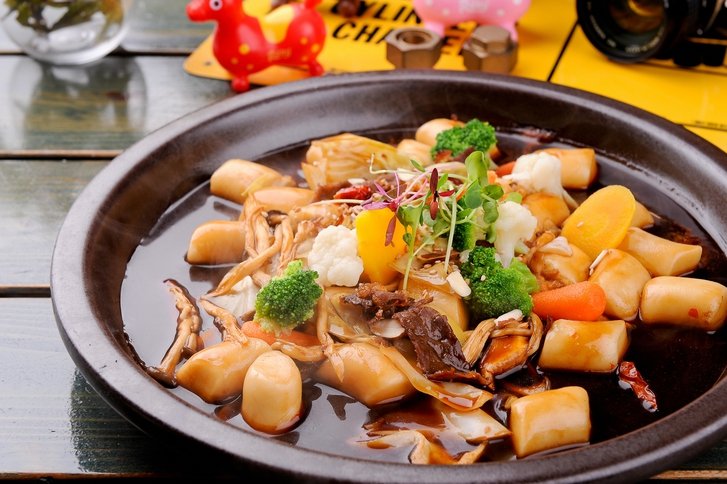Are you craving a delicious and flavorful Korean dish? Look no further than Gungjung Tteokbokki, also known as Royal Court Rice Cake. This traditional version of tteokbokki is mildly flavored with a soy sauce-based sauce, giving it a slightly sweet and savory taste. Unlike the spicy red version commonly found on the streets of Korea, Gungjung Tteokbokki was a part of royal cuisine during the Joseon Dynasty. Inspired by the popular dish japchae, this rice cake dish was created to help regain the King’s appetite. Whether you’re celebrating a special event or simply want to enjoy a tasty snack, Gungjung Tteokbokki is a must-try dish that will surely satisfy your taste buds.
Gungjung Tteokbokki (Korean Royal Rice Cake): A Delicious Twist on a Classic Dish
Are you a fan of Korean cuisine? If so, you’ve probably heard of tteokbokki, a popular Korean dish made with rice cakes and a spicy sauce. But have you ever tried its traditional version, Gungjung tteokbokki? This version is mildly flavored with a soy sauce-based sauce and is slightly sweet and deliciously savory. In this article, we’ll explore the ingredients and instructions for making this royal court rice cake dish and how you can customize it to your taste.

Ingredients
To make Gungjung tteokbokki, you will need the following ingredients:
- 1 pound thin garaetteok/tteokbokki tteok (about 2-inch long pieces)
- 4 ounces lean beef sirloin, eye round, chuck tender, or rib eye
- 3 or 4 shiitake mushrooms, fresh or soaked if dried
- 1/2 medium zucchini (about 4 ounces), or substitute with garlic chives and/or colorful bell peppers
- 1 medium carrot, cut into thin 2-inch strips
- 1/2 medium sweet onion, thinly sliced
- 1 to 2 scallions, cut into 2-inch lengths
- Salt
- Cooking oil for stir-frying
For the sauce, you will need:
- 3 tablespoons soy sauce
- 1 tablespoon rice wine or mirin
- 1 tablespoon sugar
- 1 tablespoon sesame oil
- 1 teaspoon sesame seeds
- 2 teaspoons minced garlic
- Pinch of pepper
Optional garnish:
- Ginkgo nuts or pine nuts
Instructions
Now that we have all the ingredients ready, let’s dive into the step-by-step instructions for making Gungjung tteokbokki.
- Start by mixing the sauce ingredients well and set them aside. This savory sauce will be the base of your dish and add all the delicious flavors.
- Next, bring water to a boil in a medium-sized pot. Add the rice cake pieces and boil them until they float to the top. The cooking time may vary, so keep an eye on them. Once cooked, drain them with a sieve and mix them with 2 tablespoons of the prepared sauce. This will give the rice cakes a flavorful coating.
- Thinly slice the beef into about 2-inch long strips. Cut the stems off the mushrooms and slice them into thin strips. Place the beef and mushrooms in a bowl and mix them with a tablespoon of the prepared sauce. Let them marinate while you prepare the other ingredients.
- Cut the zucchini in half lengthwise and then thinly slice it crosswise and slightly diagonally to make longer cuts. Sprinkle salt over the zucchini slices and let them sit for 10-15 minutes. This step helps remove excess moisture from the zucchini. Squeeze out the excess liquid by hand.
- In a lightly heated and oiled skillet, stir-fry the onion, carrot, and zucchini over medium-high heat for about 2 minutes. Add the scallion at the end for added freshness. Transfer the cooked vegetables to a bowl.
- In the same skillet, cook the marinated beef and mushrooms over medium-high heat until the meat is cooked through, which should take about 1 to 2 minutes. Reduce the heat to medium-low and add the rice cakes. Stir-fry them for another minute or two until they are well coated in the sauce.
- Finally, add the rice cakes to the bowl with the vegetables, along with the optional ginkgo or pine nuts and the remaining sauce. Toss everything together to ensure the flavors are well combined. Adjust the seasoning with additional soy sauce or sugar if needed.
- Serve your Gungjung tteokbokki warm and enjoy!

Optional Garnish
For an extra touch of flavor and presentation, you can garnish your Gungjung tteokbokki with ginkgo nuts or pine nuts. These traditional garnishes add a nutty flavor and a delightful crunch to the dish.
More Savory Rice Cake Recipes
If you enjoyed making and eating Gungjung tteokbokki, you might want to explore other savory rice cake recipes as well. Here are a few delicious options to try:
- Tteokbokki (Spicy Stir-fried Rice Cake): This is the classic spicy version of tteokbokki that you might be more familiar with.
- Seafood Cheese Tteokbokki: Take your tteokbokki to the next level by adding a cheesy seafood twist.
- Soupy Tteokbokki: If you prefer a lighter, soupy version of tteokbokki, this recipe is for you.
- Tteokguk (Rice Cake Soup): Enjoy rice cakes in a comforting soup for a traditional Korean New Year’s dish.
These recipes offer different flavor profiles and textures, allowing you to enjoy rice cakes in various ways.

Conclusion
Gungjung tteokbokki, or Korean royal rice cake, is a wonderful twist on the classic spicy version of tteokbokki. With its mild, savory flavors and slightly sweet taste, it offers a delightful alternative for those who prefer a lighter sauce. By following the simple instructions and customizing the ingredients to your liking, you can create a delicious Gungjung tteokbokki dish that will impress your friends and family. Enjoy this traditional Korean recipe as a snack or a light meal any time of the year!









